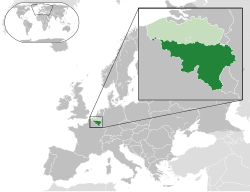Wallonia
| |
|---|---|
|
| |
| Anthem: Le Chant des Wallons ("The song of the Walloons") | |
 | |
 | |
| Coordinates: 50°30′0'N, 4°45′ 0″ E | |
| Country | Belgium |
| Community | French Community German-speaking Community |
| Capital | Namur |
| Government | |
| • Executive | Government of Wallonia |
| • Governing parties (2024) | MR and Les Engagés |
| • Minister-President | Adrien Dolimont (MR) |
| • Legislature | Parliament of Wallonia |
| • Speaker | Willy Borsus (MR) |
| Area | |
• Total | 16,901[1] km2 (6,526 sq mi) |
| Population (1 January 2024)[2] | |
• Total | 3,692,283 |
| • Density | 220/km2 (570/sq mi) |
| Demonym | Walloons |
| Demographics | |
| • Languages | French German (in the German-speaking Community of Belgium) Dutch (in municipalities with language facilities)[3] Walloon |
| GDP | |
| • Total | €126.691 billion (2022) |
| ISO 3166 code | BE-WAL |
| Celebration Day | Third Sunday of September |
| Most populous city | Charleroi |
| Website | www.wallonie.be |
Wallonia (/wɒˈloʊniə/ wol-OH-nee-ə; French: Wallonie [walɔni]; Walloon: Waloneye or Walonreye),[a] officially the Walloon Region (French: Région wallonne; Walloon: Redjon walone),[b] is one of the three regions of Belgium—along with Flanders and Brussels.[5] Covering the southern portion of the country, Wallonia is primarily French-speaking. It accounts for 55% of Belgium's territory, but only a third of its population. The Walloon Region and the French Community of Belgium, which is the political entity responsible for matters related mainly to culture and education, are independent concepts, because the French Community of Belgium encompasses both Wallonia and the bilingual Brussels-Capital Region but not the German-speaking Community of Belgium.
During the Industrial Revolution, Wallonia was second only to the United Kingdom in industrialization, capitalizing on its extensive deposits of coal and iron. This brought the region wealth, and from the beginning of the 19th to the middle of the 20th century, Wallonia was the more prosperous half of Belgium. Since World War II, the importance of heavy industry has greatly diminished, and the Flemish Region has exceeded Wallonia in wealth as Wallonia has declined economically. Wallonia now suffers from high unemployment and has a significantly lower GDP per capita than Flanders. The economic inequalities and linguistic divide between the two are major sources of political conflicts in Belgium and a major factor in Flemish separatism.
The capital of Wallonia is Namur, and the most populous city is Charleroi. Most of Wallonia's major cities and two-thirds of its population lie along the east–west aligned Sambre and Meuse valley, the former industrial backbone of Belgium. To the north of this valley, Wallonia lies on the Central Belgian Plateau, which, like Flanders, is a relatively flat and agriculturally fertile area. The south and southeast of Wallonia is made up of the Ardennes, an expanse of forested highland that is less densely populated.
There is a German-speaking minority in eastern Wallonia, resulting from the annexation of three cantons previously part of the German Empire at the conclusion of World War I. This community represents less than 1%[6] of the Belgian population. It forms the German-speaking Community of Belgium, which has its own government and parliament for culture-related issues.
Wallonia borders Flanders and the Netherlands (the province of Limburg) in the north, France (Grand Est and Hauts-de-France) to the south and west, and Germany (North Rhine-Westphalia and Rhineland-Palatinate) and Luxembourg (Capellen, Clervaux, Esch-sur-Alzette, Redange and Wiltz) to the east. Wallonia has been a member of the Organisation Internationale de la Francophonie since 1980.
- ^ a b "be.STAT". Bestat.statbel.fgov.be.
- ^ "Structuur van de bevolking | Statbel". Statbel.fgov.be.
- ^ "Vlaamse overheid – Taalwetwijzer – Wetgeving". Vlaanderen.be.
- ^ "EU regions by GDP, Eurostat". Retrieved 18 September 2023.
- ^ The Belgian Constitution (PDF). Brussels, Belgium: Belgian House of Representatives. May 2014. p. 5. Archived from the original (PDF) on 10 August 2015. Retrieved 10 September 2015.
Article 3: Belgium comprises three Regions: the Flemish Region, the Walloon Region and the Brussels Region. Article 4: Belgium comprises four linguistic regions: the Dutch-speaking region, the French-speaking region, the bilingual region of Brussels-Capital and the German-speaking region.
- ^ "BBC – Languages – Languages". Bbc.co.uk.
Cite error: There are <ref group=lower-alpha> tags or {{efn}} templates on this page, but the references will not show without a {{reflist|group=lower-alpha}} template or {{notelist}} template (see the help page).

